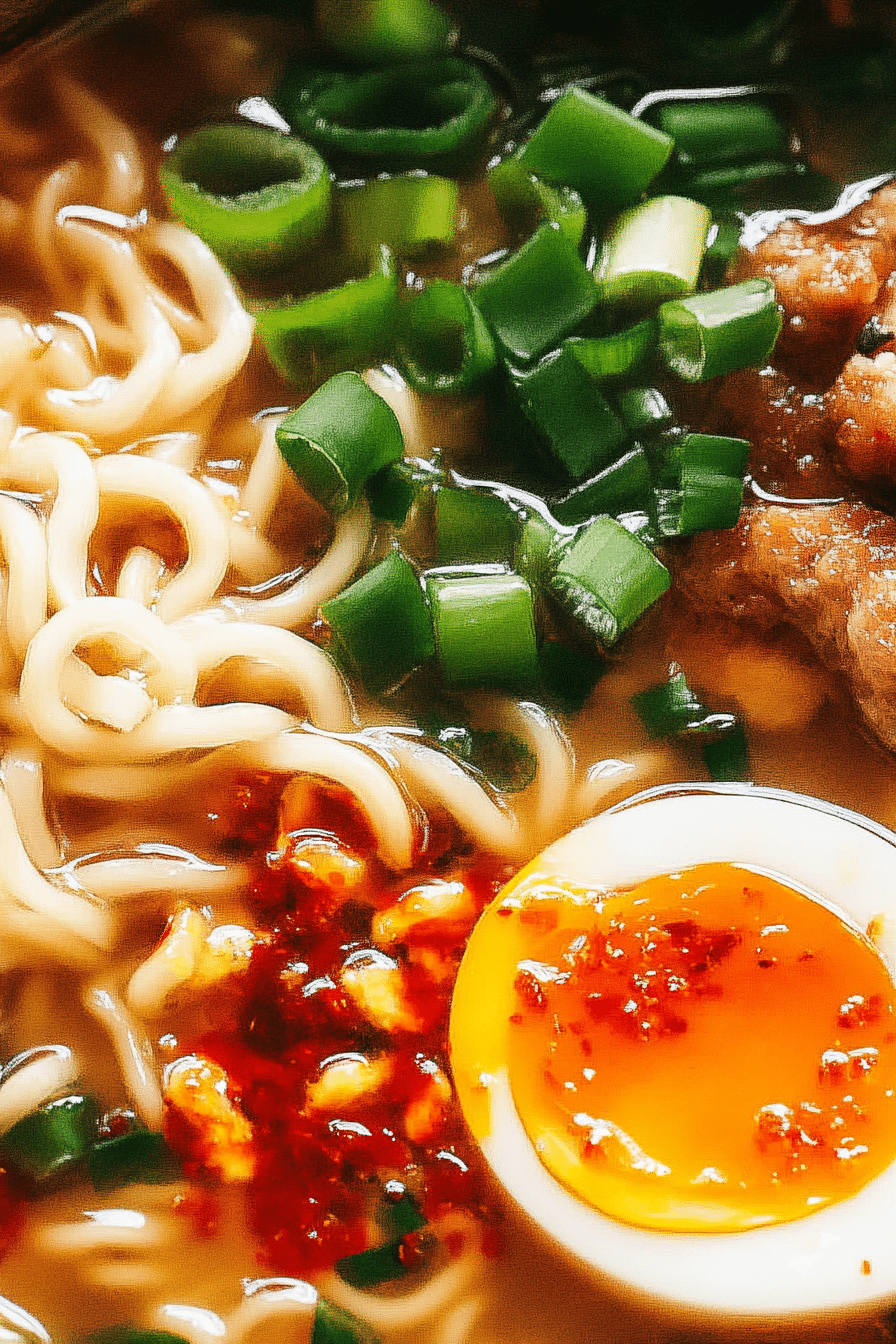There’s something about a steaming bowl that instantly feels like a hug in a mug, right? I’m transported back to weekends with my grandma, the kitchen smelling of garlic, ginger, and sesame oil, while the kettle hisses softly on the stove. This Quick Homemade Ramen is basically that memory in a modern, weeknight-friendly bowl. It’s incredibly comforting, but you don’t have to spend hours to get there. I always say it’s the grown-up version of a pantry-friendly noodle soup—the kind you can throw together in under 30 minutes if you plan a little. This one’s a lifesaver on busy nights, and my kids actually ask for seconds. The broth has this glossy, savory depth from miso and soy, and the toppings turn a simple noodle soup into something that feels special. I’ve even tested it with almond milk in the broth once, and you know what? It made it creamier and gave a nice nutty note that surprised everyone. This is the kind of dish that grows with you—the more you play, the cozier it becomes.
Thank you for reading this post, don't forget to subscribe!What is a quick home made ramen?
Think of Quick Homemade Ramen as a personal, spoonful-sized celebration of cozy flavors you can pull together in a flash. It’s essentially a bowl of noodles swimming in a bright, deeply flavorful broth, finished with a handful of toppings that you can mix and match depending on what’s in your fridge. The name ramen comes from Japan, but the idea is delightfully universal: a warm, adaptable bowl that feels like home no matter where you are. This version leans on miso, soy, and ginger for comfort with a touch of sweetness to keep it balanced. It’s essentially your favorite noodle soup, upgraded with a few pantry-friendly tricks so you don’t need a long simmering day to enjoy it. The result is a luminous, savory broth, tender noodles, a soft-boiled egg or two, and toppings that bring color and texture. It’s friendly for weeknights and forgiving for leftovers, too.
Why you’ll love this recipe?
What I love most about this Quick Homemade Ramen is how forgiving it feels while still tasting like you put real effort into it. It’s got a flavor punch that rivals a restaurant bowl, without the fuss. Here’s why it tends to disappear in minutes at my house:
- Flavor: The broth is silky and savory, with miso’s umami, a kiss of soy, and a little sweetness that keeps every sip balanced. The aromatics—ginger, garlic, scallions—lift everything and make the kitchen smell irresistible.
- Simplicity: You can pull this together in about 25–30 minutes if you keep toppings simple and the broth on the stove rather than in the fridge. It’s the kind of dish where you feel like you’ve hacked the weeknight dinner game.
- Cost-efficiency: What is the best way to measure cost-efficiency?: A few pantry staples go a long way—stock, miso, soy, and eggs—so you’re not breaking the bank for a glorious bowl. Toppings can be swapped with what’s in your crisper, making it even more budget-friendly.
- Versatility: Whether you’re a meat-eater, vegetarian, or somewhere in between, you can tailor the toppings to your family’s tastes. It’s already a good match for chicken, pork, tofu, or just mushrooms for a mushroom-forward bowl.
- Make-ahead friendly.: You can prep the broth ahead of time, refrigerate, and heat when you’re ready to serve. The noodles are best fresh, but they don’t demand a perfect timing dance—simple quick-cook noodles work beautifully.
What I love most about this recipe is the way it invites your own personality. It’s not precious. It’s a weeknight friend you can rely on. If you’ve got a carrot, some spinach, or a stray mushroom, toss it in. If you’re in the mood for a little heat, drizzle some chili oil. If you’re craving a more luxe feel, top with charred scallions and a slice of chashu. The dish welcomes improvisation, and that freedom makes it mine—and yours—each time we make it.
How to Make Quick Homemade Ramen
Quick Overview
This ramen comes together in a few simple stages: you build a bright, cozy broth with miso and aromatics, cook the noodles just until al dente, prep a few toppings that bring texture and color, and then assemble the bowls with a final flourish of glaze or chili oil. The beauty is in the pace: everything can happen within a busy evening, and you can swap ingredients as your fridge dictates. It’s the kind of dish where you taste as you go, adjusting salt and sweetness to your liking, so don’t stress the first time—taste, tweak, enjoy.
Ingredients
For the Main Broth:
– 4 cups low-sodium chicken stock or vegetable stock
– 2 cups water
– 2 tablespoons white miso paste (or 1 tablespoon miso plus 1 teaspoon white miso for lighter color)
– 1 tablespoon soy sauce (use tamari for gluten-free if needed)
– 1 teaspoon sugar or honey (optional, to balance saltiness)
– 1 teaspoon sesame oil
– 1-inch piece fresh ginger, sliced
– 2 garlic cloves, smashed
– Optional: 1 strip kombu or a few dried shiitake mushrooms for depth
For the Noodles:
– 9 oz fresh ramen noodles (or substitute with Chinese-style egg noodles or spaghetti in a pinch)
– Salt for the boiling water
For the Filling:
– 4 soft-boiled eggs (you’ll want a runny yolk, about 6–7 minutes in boiling water)
– 8 oz protein of choice (thinly sliced pork belly or chicken thigh, or firm tofu; marinate if you like: 1 tablespoon soy, 1 teaspoon honey, 1 teaspoon rice wine or mirin)
– 1 cup shiitake mushrooms or button mushrooms, sliced
– 2 scallions, thinly sliced
For the Glaze (Finish & Toppings):
– Chili oil or a squeeze of sriracha, to taste
– 1 teaspoon toasted sesame seeds (optional)
– Nori sheets, cut into small strips (optional)
– Extra scallions for finishing
Step-by-Step Instructions
Step 1: Preheat & Prep Pan
Set a large, sturdy pot over medium heat. You’re not frying here, but you want a bit of warmth to perfume the aromatics. Have your garlic, ginger, and mushrooms ready, and line up your toppings so you can grab them quickly as the broth comes together. This is the moment where I tell myself, “This is doable,” and then it always is.
Step 2: Mix Dry Ingredients
In a small bowl, whisk together the miso paste, sugar (if using), and a pinch of salt. The miso loves a touch of warmth to unlock its savory sweetness, so blending first helps it dissolve smoothly when it hits the hot liquid.
Step 3: Mix Wet Ingredients
In the pot, add the chicken or vegetable stock and water. Bring to a simmer over medium heat. Add the sliced ginger and smashed garlic to perfume the broth. If you’re using kombu or dried shiitake, tie them in a piece of cheesecloth or simply toss them in—they’ll mellow after a few minutes.
Step 4: Combine
Stir in the dry-mixed miso-sugar-salt mixture and the soy sauce. Let the broth simmer gently for 8–12 minutes, allowing the flavors to mingle. If it starts tasting flat, a quick splash more soy or a tiny pinch of sugar can bring it back into balance. I often season at the end, after the noodles are ready, so I don’t oversalt the broth before tasting the final bowl.
Step 5: Prepare Filling
While the broth simmers, prepare your toppings. If you’re roasting pork, pop thin slices into a hot pan with a bit of oil to color and then finish them in the oven for 8–10 minutes. Sauté mushrooms in a splash of soy and a whisper of sesame oil until they’re deeply golden. Soft-boil the eggs and peel them; you want the yolk just shy of jammy so it oozes when you cut into it.
“Packed with flavor and so simple. Exactly what I wanted from this Quick Homemade Ramen!”
Step 6: Layer & Swirl
Cook the noodles in a separate pot in well-salted water until just shy of al dente, 2–3 minutes for fresh ramen, longer for dried noodles. Drain, rinse lightly to remove excess starch, and set aside. When you ladle the broth, consider a quick swirl of chili oil or sesame oil into each bowl to create a marbled, fragrant surface. It’s these little swirls that make the first bite feel special.
Step 7: Bake
If you’re roasting pork or chicken for toppings, this is the moment to bake it. Preheat the oven to 375°F (190°C). Roast thinly sliced pork belly or chicken thigh with a light brush of soy and a touch of honey for 12–15 minutes, until the edges are caramelized and the center is tender. Slice thinly to nestle into the bowls or to arrange on top. The oven adds that caramel glaze that makes the bowls look restaurant-worthy without much effort.
Step 8: Cool & Glaze
Let the roasted meat rest a minute, then brush with a little extra glaze from the pan juices so every piece glistens. If you’ve marinated eggs, this is a good moment to gently coat them in a light soy-based glaze or simply keep them plain and glossy with a touch of sesame oil. The goal is to have glossy, flavorful bites that contrast nicely with the hot broth.
Step 9: Slice & Serve
Now it’s time to assemble. Place the hot noodles in bowls, ladle the steaming broth over them, and arrange the toppings—piled pork, mushroom, egg halves, scallions, nori—beautifully. If you like a little drama, drizzle chili oil in a circular motion around the rim before serving. A sprinkle of sesame seeds finishes it off. Serve immediately while everything is bright and warm, and feel the compliments roll in as the first spoonful vanishes.
What to Serve It With
This Quick Homemade Ramen shines all on its own, but you can stretch it into a fuller meal by pairing it with a few simple sides or variations. Here are ideas organized by mood and occasion:
For Breakfast: A lighter, miso-forward broth with more greens and a soft-boiled egg. Add a splash of yuzu or lemon juice for a morning zing. Serve with a slice of citrus-punchy quick bread to echo the brightness in the bowl.
For Brunch: A ramen bar vibe—offer a few toppings: soft-boiled eggs, blanched spinach, chili oil, sesame seeds, and a plate of sliced scallions so guests can customize bowls as they chat. Pair with a smooth latte or a light green tea.
As Dessert: Not traditional, but if you’re craving something savory-sweet, try a miso-maple glaze on roasted nuts served alongside a small bowl of black sesame ice cream. The contrast is oddly delightful and a playful end to a playful meal.
For Cozy Snacks: Keep the toppings simple and offer extra broth for dipping thin slices of bread or spring rolls. This is the kind of meal you grab when rain taps the window and you just want warmth and comfort in a bowl.
In our family, this is a dish that invites sharing. My sister will sauté a handful of bok choy to tuck into bowls, my dad will splash a little hot sauce like he’s teaching a taste bud to dance, and my kids will garnish with scallions like tiny green fireworks. It’s become a little ritual—the kitchen lights dim a touch, the broth steams, and we gather around a table that’s quickly too small for all the joy it carries.
Top Tips for Perfecting Your Quick Homemade Ramen
Here are the tricks I’ve learned after countless bowls and a few near-misses. They’re small things, but they add up to major flavor and texture improvements.
Noodle Prep: Salt the water generously and cook noodles to just shy of package instructions. Ramen noodles go from perfect to overcooked surprisingly fast. If you’re using dried noodles, start checking a minute earlier than the timer says. Rinse lightly if you must, but don’t drown the starch—some starch helps the broth cling to the noodles.
Broth Balance: Start with less salt than you think you need; you can always add more. If you’re using miso, add it toward the end so you preserve its delicate aroma. A touch of sweetness (sugar or honey) helps balance the salt and enhances the miso’s natural sweetness; adjust to taste after you’ve tasted the broth with noodles.
Swirl Customization: A quick swirl of chili oil into the broth at the last moment is a game changer. It creates a color contrast and a fragrance that wakes up the entire bowl. If you prefer a milder finish, drizzle a little sesame oil instead for a toasty, nutty aroma.
Ingredient Swaps: Use tamari for gluten-free needs, and switch pork for chicken or tofu if you’re cooking for vegetarians. If you don’t have fresh ginger, a pinch of ginger powder works in a pinch—though fresh really does lift the aroma.
Texture & Color: Don’t skip greens. A handful of spinach, bok choy, or even napa cabbage adds crunch and color. Slice toppings thinly so every bite is a mix of soft egg, tender noodle, and crisp greens. Think about contrast—soft egg, chewy noodles, crisp toppings—every bowl should feel like a texture story.
“The Quick Homemade Ramen turned out amazing. My kids asked for seconds. Saving this one!”
Breadth of Flavor: If you want more depth, simmer the broth with a strip of kombu and then remove it just before serving. The kombu adds a round, ocean-y umami that lingers pleasantly on the palate.
Make-Ahead Wisdom: Broth can be made ahead and refrigerated for up to 3 days or frozen for up to 1 month. Reheat gently and taste for seasoning before serving. Noodles are best cooked fresh, but you can keep them on standby in a little salted water and drain when ready to serve. Eggs can be marinated a day ahead for extra flavor—just keep them in soy-based marinade in the fridge.
Storing and Reheating Tips
Storing and reheating ramen without sacrificing flavor or texture is totally doable with a little know-how. Here’s how I keep it fresh and vibrant.
Room Temperature: If you assemble bowls with hot broth and toppings, don’t leave them out at room temperature for more than two hours. It’s better to refrigerate leftovers promptly and reheat.
Refrigerator Storage: Store broth separate from noodles and toppings. Keep the soft-boiled eggs whole or peeled in a sealed container. Noodles should be kept separate because they soak up broth and can become soggy if stored together. Use airtight containers for the best results, and label with the date.
Freezer Instructions: Broth freezes well for up to 3 months. Noodles don’t freeze well; they tend to become mushy when thawed. If you’re freezing components, freeze the protein and mushroom toppings separately from the broth and reassemble with fresh noodles when reheating.
Glaze Timing Advice: If you plan to glaze pork as a topping, glaze after reheating rather than before freezing. The glaze tends to lose its sheen and clinginess when reheated from frozen, so brush on fresh glaze just before serving for a more polished look.
Quality indicators: the broth should taste bright and balanced after reheating; noodles should still have a gentle bite; toppings should be vibrant and not water-logged. If the broth tastes flat, a tiny splash of soy or a pinch of miso can revive it without over-salting again.
Frequently Asked Questions
Final Thoughts
When I think back on the first bowls I made, I’m reminded of the first time I let myself play with miso, the way the broth turned out richer after a few extra minutes, and the day my family gathered around the table with bowls in hand, noses stained slightly from the steam and smiles wide. This Quick Homemade Ramen is more than a weeknight trick—it’s a little ritual you can shape to your life. It travels from pantry-friendly to proudly seasonal by swapping toppings, from a simple mushroom twist to a pork-tinged crowning moment. It’s forgiving enough for kitchen beginners and sophisticated enough to feel special for guests. If you’re ever in a dinner pinch, this bowl will save you, and you’ll probably want to save a little memory too—the one where you realize that warmth, flavor, and comfort can all come together in a single pot, in under half an hour. Happy cooking, friends, and I can’t wait to hear how yours turns out!

Quick Homemade Ramen
Ingredients
Main Ingredients
- 1 tablespoon sesame oil
- 3 teaspoons grated ginger
- 4 teaspoons grated garlic
- 4 cups broth (chicken or vegetable)
- 4 cups water
- 1 ounce dried shiitake mushrooms
- 2 packages instant ramen noodles (noodles only)
- 0.5 cup chopped scallions or chives
- 2 cups chopped kale (or spinach)
- 1 cups shredded carrots (or another vegetable like bok choy)
- Sriracha to taste
- crunchy golden panko crumbs for topping (see notes)
- soft-boiled egg optional, for topping (see notes)
- chili oil optional, to taste
- hot sauce optional, to taste
- soy sauce optional, to taste
- salt optional, to taste
Instructions
Preparation Steps
- Heat the sesame oil in a large skillet over medium low heat. Add the garlic and ginger; stir fry for 2 minutes or until soft and fragrant.
- Add the broth and the water. Bring to a simmer; add the mushrooms and simmer for 10 minutes or until the mushrooms have softened and the broth is flavorful.
- Add the instant noodles to the hot liquid and simmer for an additional 5 minutes or until the noodles have softened. Add the scallions and stir to combine.
- Remove from heat, stir in the kale and carrots, and top with crunchy panko crumbs (see notes) and a soft-boiled egg (optional). Season with chili oil, hot sauce, sesame oil, and/or soy sauce and salt to taste.











